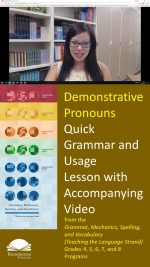Demonstrative Pronouns
Demonstrative Pronouns
Play the quick video lesson HERE and click the upper left back arrow to return to this lesson.
Common Core Language Standard 1
Demonstrative pronouns are different than demonstrative adjectives. The only difference is that the former stands on its on while the latter connects to a following noun. Both rely on our knowledge of distance for proper usage.
Today’s grammar and usage lesson is on demonstrative pronouns. Remember that a pronoun takes the place of a noun.
Now let’s read the grammar and usage lesson and study the examples.
When the words this, that, these, and those take the place of nouns, they are called demonstrative pronouns. The words this (singular) and these (plural) are close to the writer (speaker). The words that (singular) and those (plural) are away from the writer (speaker). If the demonstrative pronoun has a vague (unclear) reference to its noun, add the noun after the pronoun.
Examples: this right here, that over there, these up close, those far away
Now circle or highlight what is right and revise what is wrong according to grammar and usage lesson.
Practice: This right there is heavier than these over here. This is lighter than this other car.
Let’s check the Practice Answers.
Grammar and Usage Practice Answers:
This right here is heavier than those over there. This is lighter than that other car.
or
That right there is heavier than these over here.
That is lighter than this other car.
Now let’s apply what we have learned.
Writing Application: Write your own sentence using a demonstrative pronoun.
*****

Pennington Publishing Grammar Programs
Teaching Grammar, Usage, and Mechanics (Grades 4, 5, 6, 7, 8, and High School) are full-year, traditional, grade-level grammar, usage, and mechanics programs with plenty of remedial practice to help students catch up while they keep up with grade-level standards. Twice-per-week, 30-minute, no prep lessons in print or interactive Google slides with a fun secret agent theme. Simple sentence diagrams, mentor texts, video lessons, sentence dictations. Plenty of practice in the writing context. Includes biweekly tests and a final exam.
Grammar, Usage, and Mechanics Interactive Notebook (Grades 4‒8) is a full-year, no prep interactive notebook without all the mess. Twice-per-week, 30-minute, no prep grammar, usage, and mechanics lessons, formatted in Cornell Notes with cartoon response, writing application, 3D graphic organizers (easy cut and paste foldables), and great resource links. No need to create a teacher INB for student make-up work—it’s done for you! Plus, get remedial worksheets, biweekly tests, and a final exam.
Syntax in Reading and Writing is a function-based, sentence-level syntax program, designed to build reading comprehension and increase writing sophistication. The 18 parts of speech, phrases, and clauses lessons are each leveled from basic (elementary) to advanced (middle and high school) and feature 5 lesson components (10–15 minutes each): 1. Learn It! 2. Identify It! 3. Explain It! (analysis of challenging sentences) 4. Revise It! (kernel sentences, sentence expansion, syntactic manipulation) 5. Create It! (Short writing application with the syntactic focus in different genre).
Get the Diagnostic Grammar, Usage, and Mechanics Assessments, Matrix, and Final Exam FREE Resource:
![]()
